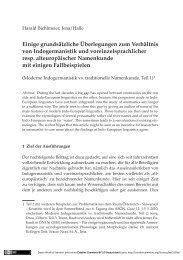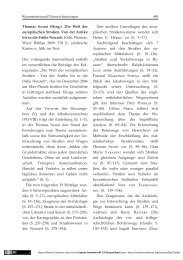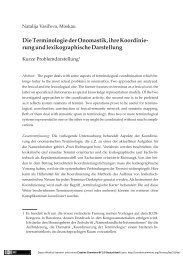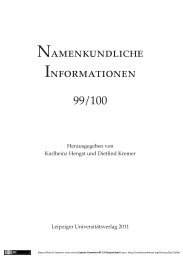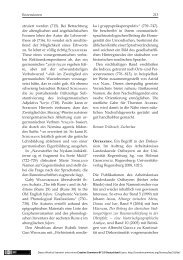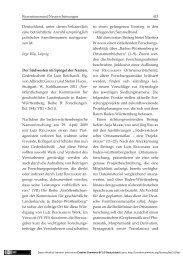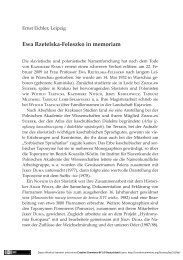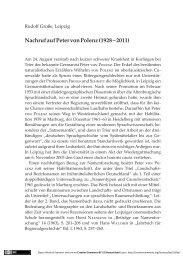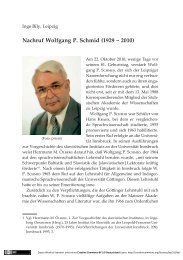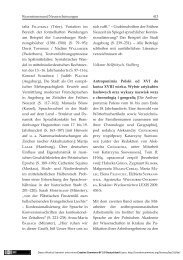Proper Names in the Light of Theoretical Onomastics
Proper Names in the Light of Theoretical Onomastics
Proper Names in the Light of Theoretical Onomastics
Create successful ePaper yourself
Turn your PDF publications into a flip-book with our unique Google optimized e-Paper software.
90 V<strong>in</strong>cent Blanárfrom scholars <strong>in</strong> <strong>the</strong> social sciences. From <strong>the</strong> beg<strong>in</strong>n<strong>in</strong>g <strong>of</strong> <strong>the</strong> 19 th century,<strong>the</strong> older pre-scientific <strong>in</strong>terpretations were replaced by historical andphilological <strong>in</strong>terpretations which focused ma<strong>in</strong>ly on reveal<strong>in</strong>g <strong>the</strong> etymology(derivational basis) <strong>of</strong> a name. Etymological analyses represent animportant material especially for habitation history. Even now, research<strong>in</strong>to <strong>the</strong> etymology <strong>of</strong> proper names is attractive although it does not completelycover <strong>the</strong> extensive problems <strong>of</strong> this rich layer <strong>of</strong> vocabulary. After<strong>the</strong> First and, <strong>in</strong> particular, <strong>the</strong> Second World War, <strong>the</strong> systematic andorganised research <strong>in</strong>to proper names developed its own methodologyand what had been an auxiliary branch <strong>of</strong> <strong>the</strong> historical and o<strong>the</strong>r socialsciences was transformed <strong>in</strong>to an <strong>in</strong>dependent discipl<strong>in</strong>e (onomastics) <strong>in</strong>which <strong>the</strong> l<strong>in</strong>guistic component (for a long time a positivistic attitude prevailed)took precedence over <strong>the</strong> historical and geographical components.The systematic process<strong>in</strong>g <strong>of</strong> <strong>the</strong> three basic areas <strong>of</strong> proper names (bionyms,toponyms and chrematonyms) was required to develop an appropriateonomastic methodology and methods for particular work<strong>in</strong>g areas.S<strong>in</strong>ce <strong>the</strong> second half <strong>of</strong> <strong>the</strong> 20 th century, a general onomastic <strong>the</strong>ory hasbeen develop<strong>in</strong>g. <strong>Onomastics</strong> has become established as a relatively <strong>in</strong>dependentdiscipl<strong>in</strong>e <strong>of</strong> l<strong>in</strong>guistics with extensive connections to o<strong>the</strong>r discipl<strong>in</strong>es<strong>of</strong> social and natural sciences.The social significance <strong>of</strong> onymy <strong>in</strong> communication and <strong>in</strong> state adm<strong>in</strong>istrationpromoted a rapid growth <strong>of</strong> research <strong>in</strong>to onomastics whichcould also be sourced from extensive materials and from <strong>the</strong> elucidation<strong>of</strong> actual problems <strong>in</strong> specialist journals <strong>of</strong> onomastics. Its developmentwas positively affected by regular <strong>in</strong>ternational congresses on onomastics(<strong>the</strong> first one was held <strong>in</strong> Paris <strong>in</strong> 1938) and conferences organised by <strong>the</strong>national onomastics committee (<strong>the</strong> Slovak Committee on <strong>Onomastics</strong> wasestablished, on <strong>the</strong> basis <strong>of</strong> <strong>the</strong> concept <strong>of</strong> research <strong>in</strong>to onomastics by V.Blanár, <strong>in</strong> 1964). <strong>Onomastics</strong> has its high-level <strong>in</strong>ternational organisation(Comité <strong>in</strong>ternational des sciences onomastiques). At <strong>the</strong> end <strong>of</strong> <strong>the</strong> 20 th centuryand <strong>in</strong> <strong>the</strong> 21 st century, several <strong>in</strong>ternational compendia were published,demonstrat<strong>in</strong>g what aims have been achieved by current ono mastics;some <strong>of</strong> <strong>the</strong>m even aimed at contribut<strong>in</strong>g to a certa<strong>in</strong> methodo logical approximation<strong>in</strong> order to form a better basis for future comparative syn<strong>the</strong>ses(compare Reader zur Namenkunde 1994 –1996; Słowiańska onomastyka.Encyklopedia 2002 / 03; Namenarten und ihre Erforschung. E<strong>in</strong> Lehrbuch für dasStudium der Onomastik 2004).



